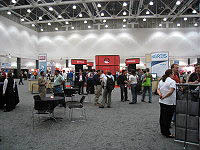Red Hat Summit 2008 opens in Boston

![]() Exhibitor area at Red Hat Summit 2008 on the eve of its opening
On Wednesday, the 18th of June, in Boston, Massachusetts, Red Hat CEO Jim Whitehurst officially opened this year's Red Hat Summit – a three-day event that mainly addresses IT decision-makers, system administrators, and developers from the company's potential customers. Red Hat and some of its partners will be presenting their products and innovations at an exhibition, while a series of lectures will provide information on current and future developments related to Red Hat Enterprise Linux (RHEL) and JBoss.
Exhibitor area at Red Hat Summit 2008 on the eve of its opening
On Wednesday, the 18th of June, in Boston, Massachusetts, Red Hat CEO Jim Whitehurst officially opened this year's Red Hat Summit – a three-day event that mainly addresses IT decision-makers, system administrators, and developers from the company's potential customers. Red Hat and some of its partners will be presenting their products and innovations at an exhibition, while a series of lectures will provide information on current and future developments related to Red Hat Enterprise Linux (RHEL) and JBoss.
Red Hat and a large number of its partners, traditionally use the event to announce innovations both large and small. For instance, at Red Hat Summit 2007 AMD's then-Executive Vice President Henri Richard, explained in his keynote address that AMD planned to improve the Linux support for ATI graphics hardware in order to find a solution satisfactory to the open source community. This announcement was the first clear sign of close cooperation between open source programmers and the GPU developers previously taken over by AMD.
A few months later, specific steps were taken that were both visible and noticeable to the public, resulting in the publication of numerous documents concerning internal matters on how to work with current Radeon graphics chips. Since the summer of 2007, open source developers have therefore been able to make considerable improvements to X.org's radeon graphics driver, the Direct Rendering Infrastructure (DRI), and the kernel; they were also able to program the new X.org driver radeonhd. Like the radeon driver, this latest driver supports practically all recent Radeon graphics cores, so that you no longer need to rely on AMD's proprietary fglrx graphics driver. Recent distributions already integrate, install, and configure these two open source drivers automatically; a few of the latest distributions even include experimental 3-D support for the X1000 Radeon series..
Even though Red Hat has managed to increase its revenue and profit over the past few months, business is still not running according to plan. According to an announcement made at the Red Hat Summit 2007, the Red Hat Global Desktop was scheduled to be released at the end of 2007, but this has yet to be seen. Furthermore, the Red Hat Exchange launched at last year's summit as a marketplace for business applications has turned out to be a bit different to expectations.
An article recently published by Red Hat discusses some of the reasons. As the article puts it, "Rumors of its death have been greatly exaggerated. RHX is different now.". Contrary to expectations, most of the firms interested in the platform apparently turned out to be large ones rather than SMEs. RHX was therefore revamped – or, as the article puts it, "...we had to change almost every aspect of the offering". But the article says that these changes had already paid off by autumn, though changes made internally at Red Hat required additional customization in the spring. RHX is focusing more on the concepts and ideas behind open source development and sees itself as a kind of helper/mediator for providers of open source software who want to implement their own business module profitably using RHX.
In the process, companies are to be brought closer to the Fedora Project that Red Hat sponsors. The exchange is also supposed to work the other way around as well; Red Hat wants Fedora developers to become more involved in RHX and has already set up a dedicated mail list, mainly for two reasons: first, the Fedora Project and its participants have all kinds of experience providing software; and second, the Fedora distribution serves as the basis for RHEL. The project already handles a public RPM depot for EPEL (Extra Packages for Enterprise Linux), which was launched last year independently of RHX and is administrated separately. The depot contains numerous RPM packets of open source software specifically tailored to RHEL versions 4 and 5, which are not included in RHEL but are contained in Fedora. The packets can be easily installed via Yum.
From Thursday to Saturday, FUDCon (the Fedora Users and Developers Conference) will be taking place near the Red Hat Summit 2008. There, Fedora developers and interested parties can meet to program, share ideas, and plan further Fedora development. Fedora 10, scheduled to be released in October/November, will probably be the main focal point. Parts of it could serve as the basis for Red Hat Enterprise Linux 6. If Red Hat sticks to the usual schedule for new RHEL versions, the next one should be released at the beginning or middle of next year.
(trk)
![Kernel Log: Coming in 3.10 (Part 3) [--] Infrastructure](/imgs/43/1/0/4/2/6/7/2/comingin310_4_kicker-4977194bfb0de0d7.png)

![Kernel Log: Coming in 3.10 (Part 3) [--] Infrastructure](/imgs/43/1/0/4/2/3/2/3/comingin310_3_kicker-151cd7b9e9660f05.png)
















